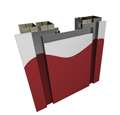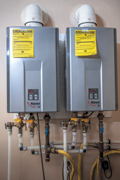Resilient Buildings that Bounce Back
Combined Heat and Power Capabilities
The ability to generate both heat and power on-site is attractive in a number of situations both for normal operations and in terms of resilience. Such combined heat and power (CHP) systems can use a propane or natural gas engine, heat exchanger, and generator to create electricity that powers the building. Simultaneously, the heat from the unit is captured by the heat exchanger and used to channel thermal energy to applications like space heating, domestic water heating, dehumidification, or other loads such as swimming pool heat. Utilizing both the electrical and thermal output of the propane CHP system achieves system efficiencies as high as 75 percent, while typical stand-alone electric generation from the grid is only about 30 to 50 percent efficient.
In commercial settings, CHP systems can greatly improve energy efficiency when compared with traditional systems. These systems are most effective in buildings with significant and steady thermal demands, which could include heavy domestic hot water needs (e.g., hotels, hospitals, car washes), swimming pool heating, or space heating through a hydronic system. CHP systems can also be ideal for retrofit situations when existing water heating equipment needs replacement, electric rates are increasing, or on-site power generation is an increasing priority. From a resiliency standpoint, most CHP systems can be used for standby power during grid-based power outages.
In many states it is even possible to sell extra electricity produced by the CHP system back to the energy grid. Where this “net metering” is permitted, these programs allow utilities to issue kilowatt-hour credits to customers, who can use them to offset any electricity consumed from the grid. In most cases, the transfer is accomplished through a bidirectional meter. The meter turns backward as excess electricity is sold to the utility. Optimized CHP systems can synchronize with utilities to operate when electric rates are highest, maximizing cost savings.
Overall, propane has been used and viewed favorably by design professionals and others as a fuel choice. Dan Weber is an architect at Anacapa in Santa Barbara, California. He notes “In rural residential projects, [propane] is just the status quo. Everyone uses propane because it’s really reliable and the cost is low. I was surprised that it was really not that expensive to do a subterranean propane tank." Related to resilience, Alex Wilson, founder of BuildingGreen and the Resilient Design Institute has stated "Propane is a good option for backup generators and offers the prospect of resilience.” Whether used as a stand-alone fuel with lower emissions than some other options or an auxiliary to clean, renewable systems, propane is a viable option.
Conclusion
Strategies have been presented for achieving better resilience in buildings. Doors that are designed and fabricated to withstand wind, flooding, and blasts help protect people on the other side of them. Properly designed and installed expansion joints and cover systems allow buildings to move and be fully operational following thermal, wind, or seismic events. On-site power generation such as can be provided by propane offers continuity in operations during utility service interruptions. Taken all together, these strategies help form an overall, holistic approach to building resilience.
Notice

www.ambico.com

www.inprocorp.com

www.propane.com










